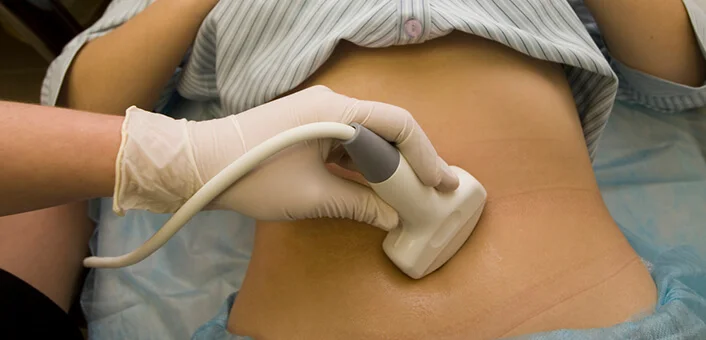
Awareness
Ovarian Cysts: Causes, Diagnosis, Symptoms & Natural Remedies
Dec 19, 2017Ovarian cysts are a fairly common condition during ovulation. Let’s look at what are ovarian cysts, their causes, their symptoms, and natural remedies to deal with them.
What Are Ovarian Cysts?
A cyst is a general term used to describe a fluid-filled structure. Ovarian cysts are fluid-filled sacs that form in or on a woman’s ovaries. The ovaries are two small, bean-shaped organs that are a part of the female reproductive system. Women have two ovaries – one on each side of the womb (uterus).
The ovaries have two main functions:
- To release an egg (ovulation) approximately every 28 days as part of the menstrual cycle
- To release the female sex hormones — oestrogen and progesterone — which play an important role in female reproduction
Ovarian cysts may affect both ovaries at the same time, or they may only affect one. Many women with ovarian cysts don’t have symptoms. Most ovarian cysts present little or no discomfort and are harmless.
Types Of Ovarian Cysts
Let’s look at the common types of ovarian cysts.
Polycystic Ovarian Syndrome
The condition known as Polycystic Ovarian Syndrome (PCOS) is characterized by the presence of multiple small cysts within both ovaries. PCOS is associated with a number of hormonal health issues and is the most common cause of infertility in women.
Follicular Cysts
The most common type of ovarian cyst is a follicular cyst, which results from the growth of a follicle. A follicle is the normal fluid-filled sac that contains an egg. Follicular cysts form when the follicle grows larger than normal during the menstrual cycle and does not open to release the egg. Usually, follicular cysts resolve on their own over the course of days to months. Follicular cysts can contain blood (hemorrhagic cysts) from leakage of blood into the egg sac.
Corpus Luteum Cysts
A Corpus luteum cyst is related to the menstrual cycle. The corpus luteum is an area of tissue within the ovary that occurs after an egg has been released from a follicle. If a pregnancy doesn’t occur, the corpus luteum usually breaks down and disappears. It may, however, fill with fluid or blood and persist as a cyst on the ovary. Usually, this cyst is found on only one side, produces no symptoms, and resolves spontaneously.
Chocolate Cysts
Endometriosis is a condition in which cells that normally grow inside as a lining of the uterus (womb), instead grow outside of the uterus in other locations. The ovary is a common site for endometriosis. When endometriosis involves the ovary, the area of endometrial tissue may grow and bleed over time, forming a blood-filled cyst. This cyst has red- or brown-colored contents called an endometrioma, sometimes referred to as a “chocolate cyst.”
Dermoid Cysts (Benign Cystic Teratomas)
Both benign and malignant tumors of the ovary may also be cystic. Occasionally, the tissues of the ovary develop abnormally to form other body tissues such as hair or teeth. Cysts with these abnormal tissues are really tumors called benign cystic teratomas or dermoid cysts.
Tubo-ovarian Abscesses
Infections of the pelvic organs can involve the ovaries and Fallopian tubes. In severe cases, pus-filled cystic spaces may be present on, in, or around the ovary or tubes. These are known as tubo-ovarian abscesses.
The vast majority of ovarian cysts are non-cancerous (benign), although a small number are cancerous (malignant). Cancerous cysts are more common in women who have been through the menopause.
Symptoms Of Ovarian Cysts
An ovarian cyst usually only causes symptoms if it splits (ruptures), is very large, or blocks the blood supply to the ovaries. In such cases, you may experience:
- Pelvic pain – this can range from a dull, heavy sensation to a sudden, severe and sharp pain
- Pain during sex
- Difficulty in emptying your bowels
- A frequent need to urinate
- Heavy periods, irregular periods or lighter periods than normal
- Bloating and a swollen tummy
- Feeling full in spite of eating little food
- Difficulty in getting pregnant. Although fertility is unaffected in most women with ovarian cysts.
See your doctor if you have persistent symptoms of an ovarian cyst.
Severe symptoms of an ovarian cyst that require immediate medical attention include:
- Severe or sharp pelvic pain
- Fever
- Faintness or dizziness
- Rapid breathing
These symptoms can indicate a ruptured cyst or an ovarian torsion. In an ovarian torsion, ovary gets twisted around the tissues that support it. Both complications can have serious consequences if not treated early.
Who Can Get Affected By Ovarian Cysts?
Women Of All Ages
Ovarian cysts are common and affect women of all ages. The vast majority of ovarian cysts are a by-product of hormonal fluctuations that occur during a menstrual cycle. Although they may become problematic, they do not indicate a specific disease process. Most ovarian cysts are not cancerous (benign), and many disappear on their own without treatment over the course of several weeks.
Women With Regular Periods
Ovarian cysts are more common in women with regular periods. In fact, most women make at least one follicle or corpus luteum cyst every month. You may not be aware that you have a cyst unless there is a problem that causes the cyst to grow or if multiple cysts form. About 8% of premenopausal women develop large cysts that need treatment. Ovarian cysts most commonly occur during a woman’s childbearing years.
Postmenopausal Women
Ovarian cysts are less common after menopause. Postmenopausal women with ovarian cysts are at a higher risk of ovarian cancer. While malignant cysts may be found along with ovarian cancer, ovarian cysts are typically not cancerous.
At any age, see your doctor if you think you have a cyst. You should also see your doctor if you have symptoms such as bloating, frequent urination, pelvic pressure or pain, or unusual vaginal bleeding. These can be signs of a cyst or other serious problem.
Ovarian Cyst Risk Factors
The following are potential risk factors for developing ovarian cysts:
- Polycystic ovarian syndrome
- History of previous ovarian cysts
- Irregular menstrual cycles
- Infertility
- Endometriosis
- Obesity
- Early menstruation (11 years or younger)
- Hyperthyroidism
- Tamoxifen therapy for breast cancer
Diagnosis Of Ovarian Cysts
A cyst on your ovary can be found during a pelvic exam. Depending on its size and whether it’s fluid filled, solid or mixed, your doctor is likely to recommend tests to determine the type of cyst and whether you need treatment. Possible tests for diagnosing ovarian cysts include:
Pelvic and Transvaginal Ultrasound
Ovarian cysts are often detected during a pelvic exam. A pelvis ultrasound can allow the doctor to see the cyst with sound waves and help determine whether it is comprised of fluid, solid tissue, or a mixture of the two. In a transvaginal ultrasound, a doctor inserts a probe into the vagina to examine the uterus and ovaries. This examination allows the doctor to view the cyst in more detail.
Cysts can also be detected with other imaging methods, such as a computerized tomography (CT) scan or MRI (magnetic resonance imaging) scan.
Because the majority of cysts disappear after a few weeks or months, your doctor may not immediately recommend a treatment plan. Instead, they may repeat the ultrasound test in a few weeks or months to check your condition.
If there aren’t any changes in your condition or if the cyst increases in size, your doctor will request additional tests to determine other causes of your symptoms.
Laparoscopy
During laparoscopy, a doctor will make small incisions and pass a thin scope (laparoscope) through the abdomen. The laparoscope will allow the doctor to identify the cyst and possibly remove or biopsy the cyst.
Serum CA-125 Assay
A cancer-antigen 125 (CA-125) blood test can help in identifying if a cyst is due to ovarian cancer. However, other conditions — including endometriosis and uterine fibroids — can also increase CA-125 levels, so this test is not specific for ovarian cancer. In some cases of ovarian cancer, levels of CA-125 are not elevated enough to be detected by a blood test.
Hormone Levels
The doctor may order a pregnancy test and assess hormone levels. Blood tests can also be performed to test for other hormonal imbalances that may cause PCOS.
Culdocentesis
Culdocentesis is performed by inserting a needle through the vaginal wall behind the uterine cervix. A fluid sample from the pelvis may be taken in order to rule out bleeding into the abdominal cavity.
Can Ovarian Cysts Be Prevented?
Ovarian cysts can’t be prevented. You cannot prevent functional ovarian cysts if you are ovulating. If you get ovarian cysts often, your doctor may prescribe hormonal birth control to stop you from ovulating. This will help in lowering your risk of getting new cysts. However, routine gynecologic examinations can detect ovarian cysts early. Benign ovarian cysts don’t become cancerous. However, symptoms of ovarian cancer can mimic symptoms of an ovarian cyst. Thus, it’s important to visit your doctor and receive a correct diagnosis. Alert your doctor to symptoms that may indicate a problem, such as:
- Changes in your menstrual cycle
- Ongoing pelvic pain
- Loss of appetite
- Unexplained weight loss
- Abdominal fullness
Treatment Of Ovarian Cysts
Treatment depends on your age, the type and size of your cyst, and your symptoms. Your doctor might suggest:
Watchful Waiting
In many cases, you can wait and get yourself re-examined to see if the cyst goes away within a few months. This is typically an option — regardless of your age — if you have no symptoms and an ultrasound shows you have a simple, small, fluid-filled cyst.
Your doctor will likely recommend that you get follow-up pelvic ultrasounds at intervals to see if there’s a change in your cyst size.
Medication
Your doctor might recommend hormonal contraceptives, such as birth control pills, to keep ovarian cysts from recurring. However, birth control pills won’t shrink an existing cyst.
Surgery
Your doctor might suggest removing a cyst that is large, doesn’t look like a functional cyst, is growing, continues through two or three menstrual cycles, or causes pain.
Some cysts can be removed without removing the ovary (ovarian cystectomy.) In some cases, your doctor might suggest removing the affected ovary and leaving the other (non-affected) ovary intact (oophorectomy.)
If a cystic mass is cancerous, your doctor will likely refer you to a gynecologic cancer specialist. You might need to have your uterus, ovaries, and fallopian tubes removed (total hysterectomy) and possibly chemotherapy or radiation. Your doctor is also likely to recommend surgery when an ovarian cyst develops after menopause.
Natural Ways To Deal With Ovarian Cysts
There are natural options that could be effective for managing functional ovarian cysts. These therapies should only be started after consulting your doctor. The key to getting rid of an ovarian cyst is to equalize your hormones and diminish factors that contribute to your cyst. Too much exposure to estrogen and xenoestrogen (estrogen imitators) can disrupt ovulation and lead to the formation of cysts.
Things To Avoid To Get Rid Of Ovarian Cyst
Processed soy products: Examples of these products include soy protein isolate and imitation meat. These products contain compounds that mimic estrogen, creating a hormonal imbalance.
Heating foods in plastic or storing hot foods in plastic: There are xenoestrogen chemicals in this material that get released into your food when heated. Use glass containers instead.
Plastic water bottles: For the same reasons, you’d avoid plastic containers.
Parabens in skin care products: They are found in many healthy foods at low levels. Your metabolic system makes them less strongly estrogenic. But applying parabens directly on your skin allows the body to absorb parabens while skipping the metabolic process.
Things To Do To Deal With Ovarian Cysts
Eat only organic meats and dairy: To avoid additives in these products that can raise estrogen levels and promote the growth of cysts.
Use natural detergents: Many laundry detergents contain xenoestrogen chemicals that can seep into your skin while you’re wearing your clothes.
Use herbal remedies: These herbs can support a proper menstrual cycle, reduce ovarian pain, and increase blood circulation to the reproductive organs. These remedies also support healthy liver function, which helps in eliminating toxins and excess hormones.
For information on specific dosing, speak to a herbalist or a naturopath who can prescribe the right amount for you.
- Maca root helps the body in producing progesterone
- Black cohosh root helps in regulating the menstrual cycle and relieves ovarian pain
- Milk thistle seed supports hormonal balance and liver health
- Tribulus normalizes ovulation
- Vitex (tree berry) regulates hormonal balance, promotes ovulation and improves the timing of menstrual cycle
- Yarrow relieves pelvic congestion and improves the timing of menstrual cycle
Do not use herbal remedies if you are pregnant or breastfeeding.
Use a castor oil pack: A castor oil pack is a cloth soaked in castor oil and placed on the skin to enhance reproductive circulation and promote the healing of bodily tissues and organs.
Note: Castor oil should not be consumed or applied to broken skin. Avoid using this if you are pregnant, breastfeeding or menstruating.








